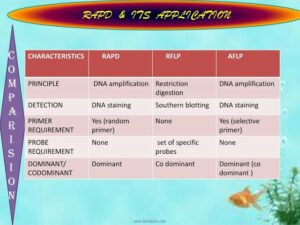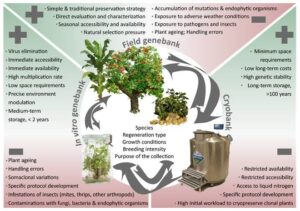Back to: Botany 400 Level
Hello, my brilliant Afrilearn learner! I’m so excited to have you back for another exciting lesson today! Are you ready to unlock the secrets of genetic diversity in crops? I know you are!
In today’s lesson, we’re going to talk about how genetic diversity is identified in crops. This is a really important topic because genetic diversity helps ensure that crops can adapt to changing environmental conditions, resist diseases, and provide food security for people all around the world.
Let’s jump right in and break it down!
Use in identifying genetic diversity in crops
Genetic diversity refers to the variety of genes within a species, and it’s crucial for the health and survival of any population, including crops. In agriculture, the more genetically diverse a crop species is, the better it can adapt to challenges like pests, diseases, droughts, and temperature changes.

Think about it: If all the maize crops in Nigeria were genetically identical, one disease could wipe them all out. But if there’s genetic diversity, some plants might be resistant, ensuring that the whole crop doesn’t perish.
To identify this diversity, scientists use various tools and techniques. Let’s explore how they do this and why it matters.
Use of Techniques to Identify Genetic Diversity in Crops
- Molecular Markers
Molecular markers are like genetic “fingerprints” of plants. They help scientists identify specific genes that make crops unique. These markers can be used to track genetic variation in crops over time or between different regions. Some of the commonly used markers include:
- RFLP (Restriction Fragment Length Polymorphism)
- AFLP (Amplified Fragment Length Polymorphism)
- SSRs (Simple Sequence Repeats)
- SNPs (Single Nucleotide Polymorphisms)
- RFLP (Restriction Fragment Length Polymorphism)
- These molecular markers allow researchers to map out the genetic differences between various crop varieties and identify traits that might be useful for breeding more resilient plants.
- DNA Fingerprinting
DNA fingerprinting is a powerful technique used to identify the genetic makeup of individual plants. It works similarly to how humans can be identified by their fingerprints. By comparing the DNA patterns of different plants, scientists can identify variations that indicate genetic diversity.
This technique is useful in studying plant populations, ensuring that genetically diverse crops are selected for breeding. For example, it helps farmers identify varieties of cassava that are resistant to cassava mosaic disease.
- Genetic Mapping
Genetic mapping involves identifying the location of genes responsible for specific traits, such as disease resistance or drought tolerance. This mapping can reveal how much genetic diversity exists in a population. By studying the genetic maps of crops like maize or rice, researchers can identify regions in the DNA where diversity is highest.
This information is vital for marker-assisted breeding, where specific genes associated with important traits are targeted to improve the crop.
- Phylogenetic Analysis
Phylogenetic analysis looks at the evolutionary relationships between different crop varieties. By comparing the genetic sequences of various crops, scientists can understand how closely related they are and identify genetic diversity. This method is useful in studying the evolution of crops and how different varieties may have adapted to various environmental challenges.
- Field Surveys and Traditional Knowledge
Alongside modern scientific techniques, field surveys and traditional knowledge play an important role in identifying genetic diversity. Farmers often maintain a variety of different crop strains that are adapted to their local environment. These varieties may be more genetically diverse than those used in large-scale commercial farming.
By documenting these local varieties and their unique traits, scientists can help preserve valuable genetic diversity for future breeding efforts.
Why is Identifying Genetic Diversity Important?
- Disease Resistance
Genetic diversity allows crops to have different levels of resistance to diseases. If a particular disease attacks one variety of a crop, other varieties with different genetic makeups may be resistant. This helps in protecting food supplies from crop losses due to disease outbreaks.
- Adaptation to Environmental Changes
Plants with higher genetic diversity are better able to cope with environmental challenges like drought, extreme temperatures, and changing rainfall patterns. In regions like Nigeria, where the weather can be unpredictable, having a range of genetically diverse crops ensures that farmers can grow plants that are suited to their local conditions.
- Improving Crop Yields
By identifying and selecting the best-performing crops from diverse genetic backgrounds, plant breeders can create varieties that are high-yielding, nutritious, and adaptable. This contributes to food security by increasing the productivity of crops like maize, cassava, and rice.
- Sustainability and Climate Resilience
Genetic diversity allows crops to adapt and survive in a changing climate. Breeding new varieties that can thrive under harsh conditions like drought or high salinity ensures that agriculture remains sustainable. For example, drought-resistant varieties of maize or rice can be developed to help farmers in regions affected by irregular rainfall.

Summary
- Genetic diversity in crops ensures that they can adapt to challenges like pests, diseases, and changing environmental conditions.
- Molecular markers, DNA fingerprinting, genetic mapping, and phylogenetic analysis are all important tools for identifying genetic diversity in crops.
- Genetic diversity helps improve disease resistance, adaptation to environmental changes, crop yields, and overall sustainability in agriculture.
Evaluation
- How do molecular markers help in identifying genetic diversity in crops?
- What is the significance of DNA fingerprinting in crop improvement?
- Why is genetic diversity important for adapting crops to climate change?
- Explain how genetic mapping can be used in marker-assisted breeding.
You’ve just learned about genetic diversity and how scientists identify it in crops. With this knowledge, you can see how important it is for ensuring that crops can resist diseases, adapt to climate changes, and continue to provide food for us in the future. Keep up the great work and stay excited for the next lesson – you’re doing amazing! Keep shining and learning with Afrilearn!
